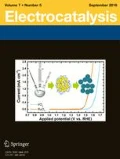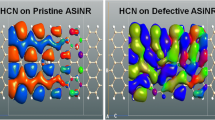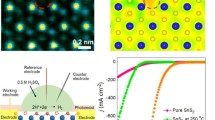Abstract
In this work, the effect of S-rich condition on the catalytic activity of the hydrogen evolution reaction in monolayer SnS2 edges was investigated using density functional theory. The results showed that the catalytic active sites for hydrogen evolution reaction (HER) in stoichiometry SnS2 monolayer locate at the (100) edge site, whereas the basal plane and (010) edge are inert for HER. The S-rich (100) and (010) edges are all catalytic active for HER with a large range of hydrogen coverage. Projected density of state analysis revealed that the mechanism for the improvement of catalytic activity is due to formation of density of states near the Fermi energy level by the S2 and S3 terminations. This work provides a new design methodology to improve the catalytic activity of catalysts based on transition metal dichalcogenides.

Graphical Abstract




Similar content being viewed by others
References
S. Dunn, Hydrogen futures: Toward a sustainable energy system. International Journal of Hydrogen Energy 27(3), 235–264 (2002)
B.H.R. Suryanto, S. Chen, J.J. Duan, C. Zhao, Hydrothermally driven transformation of oxygen functional groups at multiwall carbon nanotubes for improved electrocatalytic applications. ACS Applied Materials & Interfaces 8(51), 35513–35522 (2016)
M. Caban-Acevedo, M.L. Stone, J.R. Schmidt, J.G. Thomas, Q. Ding, H.C. Chang, M.L. Tsai, J.H. He, S. Jin, Efficient hydrogen evolution catalysis using ternary pyrite-type cobalt phosphosulphide. Nature Materials 14(12), 1245–1251 (2015)
H.H. Wu, H. Huang, J. Zhong, S. Yu, Q.B. Zhang, X.C. Zeng, Monolayer triphosphates MP3 ( M = Sn, Ge) with excellent basal catalytic activity for hydrogen evolution reaction. Nanoscale 11(25), 12210–12219 (2019)
J. Zhang, K. Sasaki, E. Sutter, R.R. Adzic, Stabilization of platinum oxygen-reduction electrocatalysts using gold clusters. Science 315(5809), 220–222 (2007)
E. Skúlason, V. Tripkovic, M.E. Björketun, S. Gudmundsdóttir, G. Karlberg, J. Rossmeisl, T. Bligaard, H. Jónsson, J.K. Nørskov, Modeling the electrochemical hydrogen oxidation and evolution reactions on the basis of density functional theory calculations. Journal of Physical Chemistry C 114(42), 18182–18197 (2010)
J. Tymoczko, F. Calle-Vallejo, W. Schuhmann, A.S. Bandarenka, Making the hydrogen evolution reaction in polymer electrolyte membrane electrolysers even faster. Nature Communications 7(1), 10990–10990 (2016)
S.H. Mir, S. Chakraborty, P.C. Jha, J. Wärnå, H. Soni, P.K. Jha, R. Ahuja, Two-dimensional boron: Lightest catalyst for hydrogen and oxygen evolution reaction. Applied Physics Letters 109(5), 053903 (2016)
H.I. Karunadasa, E. Montalvo, Y. Sun, M. Majda, J.R. Long, C.J. Chang, A molecular MoS2 edge site mimic for catalytic hydrogen generation. Science 335(6069), 698–702 (2012)
J. Xie, S. Li, X. Zhang, J. Zhang, R. Wang, H. Zhang, B.C. Pan, Y. Xie, Atomically-thin molybdenum nitride nanosheets exposing active surface sites for efficient hydrogen evolution. Chemical Science 5(12), 4615–4620 (2014)
J. Kibsgaard, T.F. Jaramillo, Molybdenum phosphosulfide: An active, acid-stable, earth-abundant catalyst for the hydrogen evolution reaction. Angewandte Chemie, International Edition 53(52), 14433–14437 (2014)
M. Chhowalla, H.S. Shin, G. Eda, L.J. Li, K.P. Loh, H. Zhang, The chemistry of two-dimensional layered transition metal dichalcogenide nanosheets. Nature Chemistry 5(4), 263–275 (2013)
C.L. Tan, X.H. Cao, X.J. Wu, Q.Y. He, J. Yang, X. Zhang, J.Z. Chen, W. Zhao, S.K. Han, G.H. Nam, M. Sindoro, H. Zhang, Recent advances in ultrathin two-dimensional nanomaterials. Chemical Reviews 117(9), 6225–6331 (2017)
L. Jiang, B. Myer, K. Tellefsen, S. Pau, A planar microfabricated electrolyzer for hydrogen and oxygen generation. Journal of Power Sources 188(1), 256–260 (2009)
J. Xie, H. Zhang, S. Li, R. Wang, X. Sun, M. Zhou, J. Zhou, X.W. Lou, Y. Xie, Defect-rich MoS2 ultrathin nanosheets with additional active edge sites for enhanced electrocatalytic hydrogen evolution. Advanced Materials 25(40), 5807–5813 (2013)
T.F. Jaramillo, K.P. Jorgensen, J. Bonde, J.H. Nielsen, S. Horch, I. Chorkendorff, Identification of active edge sites for electrochemical H2 evolution from MoS2 nanocatalysts. Science 317(5834), 100–102 (2007)
C. Tsai, F. Abild-Pedersen, J.K. Norskov, Tuning the MoS2 edge-site activity for hydrogen evolution via support interactions. Nano Letters 14(3), 1381–1387 (2014)
C. Tsai, K. Chan, F. Abild-Pedersen, J.K. Norskov, Active edge sites in MoSe2 and WSe2 catalysts for the hydrogen evolution reaction: A density functional study. Physical Chemistry Chemical Physics 16(26), 13156–13164 (2014)
J. Kibsgaard, Z.B. Chen, B.N. Reinecke, T.F. Jaramillo, Engineering the surface structure of MoS2 to preferentially expose active edge sites for electrocatalysis. Nature Materials 11(11), 963–969 (2012)
D.Y. Chung, S.K. Park, Y.H. Chung, S.H. Yu, D.H. Lim, N. Jung, H.C. Ham, H.Y. Park, Y. Piao, S.J. Yoo, Y.E. Sung, Edge-exposed MoS2 nano-assembled structures as efficient electrocatalysts for hydrogen evolution reaction. Nanoscale 6(4), 2131–2136 (2014)
H. Wang, C. Tsai, D. Kong, K. Chan, F. Abild-Pedersen, J.K. Nørskov, Y. Cui, Transition-metal doped edge sites in vertically aligned MoS2 catalysts for enhanced hydrogen evolution. Nano Research 8(2), 566–575 (2015)
J. Bonde, P.G. Moses, T.F. Jaramillo, J.K. Norskov, I. Chorkendorff, Hydrogen evolution on nano-particulate transition metal sulfides. Faraday Discussions 140, 219–231 (2008)
Y. Shi, Y. Zhou, D.R. Yang, W.X. Xu, C. Wang, F.B. Wang, J.J. Xu, X.H. Xia, H.Y. Chen, Energy level engineering of MoS2 by transition-metal doping for accelerating hydrogen evolution reaction. Journal of the American Chemical Society 139(43), 15479–15485 (2017)
X. Sun, J. Dai, Y.Q. Guo, C.Z. Wu, F.T. Hu, J.Y. Zhao, X.C. Zeng, Y. Xie, Semimetallic molybdenum disulfide ultrathin nanosheets as an efficient electrocatalyst for hydrogen evolution. Nanoscale 6(14), 8359–8367 (2014)
S. Bolar, S. Shit, J.S. Kumar, N.C. Murmu, R.S. Ganesh, H. Inokawa, T. Kuila, Optimization of active surface area of flower like MoS2 using V-doping towards enhanced hydrogen evolution reaction in acidic and basic medium. Applied Catalysis B: Environmental 254, 432–442 (2019)
G. Liu, Y. Qiu, Z. Wang, J. Zhang, X. Chen, M. Dai, D. Jia, Y. Zhou, Z. Li, P. Hu, Efficiently synergistic hydrogen evolution realized by trace amount of Pt-decorated defect-rich SnS2 nanosheets. ACS Applied Materials & Interfaces 9(43), 37750–37759 (2017)
X. Chen, Z. Wang, Y. Qiu, J. Zhang, G. Liu, W. Zheng, W. Feng, W. Cao, P. Hu, W. Hu, Controlled growth of vertical 3D MoS2(1-x)Se2x nanosheets for an efficient and stable hydrogen evolution reaction. Journal of Materials Chemistry A 4(46), 18060–18066 (2016)
A. Kagkoura, I. Tzanidis, V. Dracopoulos, N. Tagmatarchis, D. Tasis, Template synthesis of defect-rich MoS2-based assemblies as electrocatalytic platforms for hydrogen evolution reaction. Chemical Communications 55(14), 2078–2081 (2019)
S. Wenwu, W. Zhiguo, F. Yong Qing, Rhenium doping induced structural transformation in mono-layered MoS2 with improved catalytic activity for hydrogen evolution reaction. Journal of Physics D 50, 405303 (2017)
W. Shi, Z. Wang, Effect of oxygen doping on the hydrogen evolution reaction in MoS2 monolayer. J. Taiwan Inst. Chem. E. 82, 163–168 (2018)
D.Z. Wang, Y.Y. Xie, Z.Z. Wu, Amorphous phosphorus-doped MoS2 catalyst for efficient hydrogen evolution reaction. Nanotechnology 30(20), 205401 (2019)
W. Shi, S. Wu, Z. Wang, Triggering basal plane active sites of monolayer MoS2 for the hydrogen evolution reaction by phosphorus doping. Journal of Nanoparticle Research 20(10), 271 (2018)
Q.F. Gong, L. Cheng, C.H. Liu, M. Zhang, Q.L. Feng, H.L. Ye, M. Zeng, L.M. Xie, Z. Liu, Y.G. Li, Ultrathin MoS2(1-x)Se2x alloy nanoflakes for electrocatalytic hydrogen evolution reaction. ACS Catalysis 5(4), 2213–2219 (2015)
W.C. Zhang, X.B. Liao, X.L. Pan, M.Y. Yan, Y.X. Li, X.C. Tian, Y. Zhao, L. Xu, L.Q. Mai, Superior hydrogen evolution reaction performance in 2H-MoS2 to that of 1T phase. Small 15(31), 1900964 (2019)
H. Zhu, M. Du, M. Zhang, M. Zou, T. Yang, S. Wang, J. Yao, B. Guo, S-rich single-layered MoS2 nanoplates embedded in N-doped carbon nanofibers: Efficient co-electrocatalysts for the hydrogen evolution reaction. Chemical Communications 50(97), 15435–15438 (2014)
Y. Guo, X. Zhang, X. Zhang, T. You, Defect- and S-rich ultrathin MoS2 nanosheet embedded N-doped carbon nanofibers for efficient hydrogen evolution. Journal of Materials Chemistry A 3(31), 15927–15934 (2015)
Z.C. Li, J.J. Ma, Y. Zhou, Z.M. Yin, Y.B. Tang, Y.X. Ma, D.B. Wang, Synthesis of sulfur-rich MoS2 nanoflowers for enhanced hydrogen evolution reaction performance. Electrochimica Acta 283, 306–312 (2018)
W. Fengmei, L. Yuanchang, S.T. Ahmed, L. Kaili, W. Feng, W. Zhenxing, X. Peng, W. Qisheng, H. Jun, Selenium-enriched nickel selenide nanosheets as a robust electrocatalyst for hydrogen generation. Agnew. Chem. Int. Ed. 128, 7033–7038 (2016)
E. Skulason, G.S. Karlberg, J. Rossmeisl, T. Bligaard, J. Greeley, H. Jonsson, J.K. Norskov, Density functional theory calculations for the hydrogen evolution reaction in an electrochemical double layer on the Pt(111) electrode. Physical Chemistry Chemical Physics 9(25), 3241–3250 (2007)
A.P. Murthy, J. Theerthagiri, J. Madhavan, K. Murugan, Highly active MoS2/carbon electrocatalysts for the hydrogen evolution reaction – Insight into the effect of the internal resistance and roughness factor on the Tafel slope. Physical Chemistry Chemical Physics 19(3), 1988–1998 (2017)
M.R. Gao, J.X. Liang, Y.R. Zheng, Y.F. Xu, J. Jiang, Q. Gao, J. Li, S.H. Yu, An efficient molybdenum disulfide/cobalt diselenide hybrid catalyst for electrochemical hydrogen generation. Nature Communications 6(1), 5982 (2015)
G. Gao, A.P. O’Mullane, A. Du, 2D MXenes: A new family of promising catalysts for the hydrogen evolution reaction. ACS Catalysis 7(1), 494–500 (2017)
S. Liu, J. Li, B. Shi, X. Zhang, Y. Pan, M. Ye, R. Quhe, Y. Wang, H. Zhang, J. Yan, L. Xu, Y. Guo, F. Pan, J. Lu, Gate-tunable interfacial properties of in-plane ML MX2 1T′–2H heterojunctions. Journal of Materials Chemistry C 6(21), 5651–5661 (2018)
J. Zhang, Y. Zhao, X. Guo, C. Chen, C.L. Dong, R.S. Liu, C.P. Han, Y. Li, Y. Gogotsi, G. Wang, Single platinum atoms immobilized on an MXene as an efficient catalyst for the hydrogen evolution reaction. Nature Catalysis 1(12), 985–992 (2018)
D. Er, H. Ye, N.C. Frey, H. Kumar, J. Lou, V.B. Shenoy, Prediction of enhanced catalytic activity for hydrogen evolution reaction in Janus transition metal dichalcogenides. Nano Letters 18(6), 3943–3949 (2018)
C. Ling, L. Shi, Y. Ouyang, Q. Chen, J. Wang, Transition metal-promoted V2CO2 (MXenes): A new and highly active catalyst for hydrogen evolution reaction. Advancement of Science 3, 1600180 (2016)
C. Ling, L. Shi, Y. Ouyang, J. Wang, Searching for highly active catalysts for hydrogen evolution reaction based on O-terminated MXenes through a simple descriptor. Chemistry of Materials 28(24), 9026–9032 (2016)
H. Li, C. Tsai, A.L. Koh, L. Cai, A.W. Contryman, A.H. Fragapane, J. Zhao, H.S. Han, H.C. Manoharan, F. Abild-Pedersen, Activating and optimizing MoS2 basal planes for hydrogen evolution through the formation of strained sulphur vacancies. Nature Materials 15(1), 48–53 (2016)
Y. Jiao, Y. Zheng, M. Jaroniec, S.Z. Qiao, Design of electrocatalysts for oxygen- and hydrogen-involving energy conversion reactions. Chemical Society Reviews 44(8), 2060–2086 (2015)
W. Schmickler, S. Trasatti, Comment on “Trends in the exchange current for hydrogen evolution”. Journal of the Electrochemical Society 153(12), L31 (2006)
J. Greeley, T.F. Jaramillo, J. Bonde, I.B. Chorkendorff, J.K. Nørskov, Computational high-throughput screening of electrocatalytic materials for hydrogen evolution. Nature Materials 5(11), 909–913 (2006)
J.K. Nørskov, T. Bligaard, A. Logadottir, J.R. Kitchin, J.G. Chen, S. Pandelov, U. Stimming, Trends in the exchange current for hydrogen evolution. Journal of the Electrochemical Society 152, 23 (2005)
M.W. Jiang, Y. Huang, W. Sun, X.J. Zhang, Co-doped SnS2 nanosheet array for efficient oxygen evolution reaction electrocatalyst. Journal of Materials Science 54(21), 13715–13723 (2019)
Y.M. Fu, F.R. Cao, F.L. Wu, Z.D. Diao, J. Chen, S.H. Shen, L. Li, Phase-modulated band alignment in CdS nanorod/SnSx nanosheet hierarchical heterojunctions toward efficient water splitting. Advanced Functional Materials 28(16), 1706785 (2018)
R. Schlaf, N.R. Armstrong, B.A. Parkinson, C. Pettenkofer, W. Jaegermann, Van der Waals epitaxy of the layered semiconductors SnSe2 and SnS2 : morphology and growth modes. Surface Science 385(1), 1–14 (1997)
Y. Su, M.A. Ebrish, E.J. Olson, S.J. Koester, SnSe2 field-effect transistors with high drive current. Applied Physics Letters 103, 8983 (2013)
Y. Sun, H. Cheng, S. Gao, Z. Sun, Q. Liu, Q. Liu, F. Lei, T. Yao, J. He, S. Wei, Freestanding tin disulfide single-layers realizing efficient visible-light water splitting. Agnew. Chem. Int. Ed. 51(35), 8727–8731 (2012)
J.M. Soler, E. Artacho, J.D. Gale, A. Garcia, J. Junquera, P. Ordejon, D. Sanchez-Portal, The SIESTA method for ab initio order-N materials simulation. Journal of Physics. Condensed Matter 14(11), 2745–2779 (2002)
N. Troullier, J.L. Martins, Efficient psedopotentials for plane-wave calculation. Physical Review B 43(3), 1993–2006 (1991)
J.K. Norskov, J. Rossmeisl, A. Logadottir, L. Lindqvist, J.R. Kitchin, T. Bligaard, H. Jonsson, Origin of the overpotential for oxygen reduction at a fuel-cell cathode. The Journal of Physical Chemistry. B 108(46), 17886–17892 (2004)
J. Rossmeisl, A. Logadottir, J.K. Norskov, Electrolysis of water on (oxidized) metal surfaces. Chemical Physics 319(1-3), 178–184 (2005)
D. Voiry, H. Yamaguchi, J. Li, R. Silva, D.C.B. Alves, T. Fujita, M. Chen, T. Asefa, V.B. Shenoy, G. Eda, M. Chhowalla, Enhanced catalytic activity in strained chemically exfoliated WS2 nanosheets for hydrogen evolution. Nature Materials 12(9), 850–855 (2013)
S.F. Boys, F. Bernardi, The calculation of small molecular interactions by the differences of separate total energies. Some procedures with reduced errors. Molecular Physics 19, 553–566 (1970)
X. Sun, Z. Wang, Z. Li, Y.Q. Fu, Origin of structural transformation in mono- and bi-layered molybdenum disulfide. Scientific Reports 6(1), 26666 (2016)
Y. Wang, L. Huang, B. Li, J. Shang, C. Xia, C. Fan, H.X. Deng, Z. Wei, J. Li, Composition-tunable 2D SnSe2(1−x)S2x alloys towards efficient bandgap engineering and high performance (opto)electronics. Journal of Materials Chemistry C 5, 84–90 (2016)
J.J. Liu, E.D. Hua, High photocatalytic activity of heptazine-based g-C3N4/SnS2 heterojunction and its origin: Insights from hybrid DFT. Journal of Physical Chemistry C 121(46), 25827–25835 (2017)
Y. Sun, H. Cheng, S. Gao, Z. Sun, Q. Liu, Q. Liu, F. Lei, T. Yao, J. He, S. Wei, Freestanding tin disulfide single-layers realizing efficient visible-light water splitting. Agnew. Chem. Int. Ed. 51(35), 8727–8731 (2012)
S. Dong, Z. Wang, Improving the catalytic activity for hydrogen evolution of monolayered SnSe2(1−x)S2x by mechanical strain. Beilstein Journal of Nanotechnology 9, 1820–1827 (2018)
Y. Ouyang, C. Ling, Q. Chen, Z. Wang, L. Shi, J. Wang, Activating inert basal planes of MoS2 for hydrogen evolution reaction through the formation of different intrinsic defects. Chemistry of Materials 28(12), 4390–4396 (2016)
Y.R. An, X.L. Fan, Z.F. Luo, W.M. Lau, Nanopolygons of monolayer MS2: Best morphology and size for HER catalysis. Nano Letters 17(1), 368–376 (2017)
S.H. Lin, J.L. Kuo, Activating and tuning basal planes of MoO2, MoS2, and MoSe2 for hydrogen evolution reaction. Physical Chemistry Chemical Physics 17(43), 29305–29310 (2015)
B. Hammer, J. Nørskov, Electronic factors determining the reactivity of metal surfaces. Surface Science 343(3), 211–220 (1995)
Y. Hao, Y.T. Wang, L.C. Xu, Z. Yang, R. Liu, X. Li, 1T-MoS2 monolayer doped with isolated Ni atoms as highly active hydrogen evolution catalysts: A density functional study. Applied Surface Science 469, 292–297 (2019)
Author information
Authors and Affiliations
Corresponding author
Ethics declarations
Conflict of Interest
The authors declare that they have no conflicts of interest.
Additional information
Publisher’s Note
Springer Nature remains neutral with regard to jurisdictional claims in published maps and institutional affiliations.
Rights and permissions
About this article
Cite this article
Sun, Y., Wang, Z. Density Functional Theory Study on the Hydrogen Evolution Reaction in the S-rich SnS2 Nanosheets. Electrocatalysis 11, 604–611 (2020). https://doi.org/10.1007/s12678-020-00618-7
Published:
Issue Date:
DOI: https://doi.org/10.1007/s12678-020-00618-7




